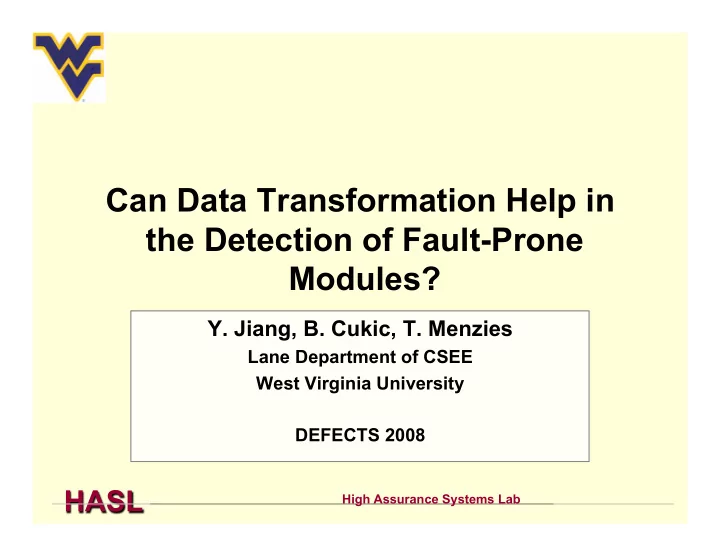

Can Data Transformation Help in the Detection of Fault-Prone Modules? Y. Jiang, B. Cukic, T. Menzies Lane Department of CSEE West Virginia University DEFECTS 2008 High Assurance Systems Lab
Background • Prediction of fault-prone modules is one of the most active research areas in empirical software engineering. – Also the one with a significant impact to practice of verification and validation. • Recent results indicate that current methods reached a “ceiling effect”. – Differences between (most) classification algorithms not statistically significant. – Different metrics suites do not seem to offer a significant advantage. Feature selection indicates relatively small number of metrics perform as well as larger sets. High Assurance Systems Lab
Motivation • Overcoming the “ceiling” requires experimentation with new approaches appropriate for our domain. – Recent history matters the most [Weyuker et. al] – Inclusion of the developer’s social networks [Zimmerman et. al.]. – Incorporating expert opinions [Khoshgoftaar et. al.]. – Utilization of early life-cycle metrics [Jiang et. al.] – Incorporating misclassification costs [Jiang et. al.] – ( your best ideas here ) • Transformation of metrics data suggested as a possible venue for the improvement [Menzies, TSE’07] High Assurance Systems Lab
Goal of study • Evaluate whether transformation (preprocessing) helps improving the prediction of fault-prone software modules? • Four data transformation methods are used and their effects on prediction compared: a) The original data, no transformation ( none ) b) Ln transformation ( log ) c) Discretization using Fayyad-Irani’s Minimum Description Length algorithm ( nom ) d) Discretization of log transformed data ( log&nom ) High Assurance Systems Lab
The Impact of Transformations High Assurance Systems Lab
Experimental Setup • 9 data sets from Metrics Data Program (MDP). • 4 transformation methods. • 9 classification algorithms for each transformation. • Ten-way cross-validation (10x10 CV). • Evaluation technique: Area Under the ROC curve (AUC). • Total AUCs: 9 datasets x 4 transformation x 9 classifiers x 10CV = 3240 models • Boxplot diagrams depict the results of each fault prediction modeling technique. • Nonparametric statistical hypothesis test tests the difference between the classifiers over multiple data sets. High Assurance Systems Lab
Metrics Data Program (MDP) data sets High Assurance Systems Lab
10 different classifiers used High Assurance Systems Lab
Statistical hypothesis test • We use the nonparametric procedure for the comparison. – 95% confidence level used in all experiments. • Performance comparison between more than two experiments: – Friedman test determines whether there are statistically significant differences amongst in classification performance across ALL experiments. – If yes, after-the-fact Nemenyi test ranks different classifiers. • For the comparison of two specific experiments, we use Wilcoxon’s signed rank test. High Assurance Systems Lab
Classification results using the original data High Assurance Systems Lab
Classification results using the log transformed data High Assurance Systems Lab
Classification results using the discretized data High Assurance Systems Lab
Classification results using the discretized log transformed data High Assurance Systems Lab
Comparing results over different data domains • Random forest ranked as one of the best classifiers in the original and log transformed domains. • Boosting ranked as one of the best classifiers in the experiments with the discretized data. • The performance comparison reveals statistically significant difference. – We compared random forest ( none and log ) vs . boosting ( nom and log&nom ) using the Wilcoxon signed ranked test, using 95% confidence interval • Random forest in original and log transformed domains beats Boosting in discretized domains. High Assurance Systems Lab
Comparing the classifiers across the four transformation domains Better for none and log Better for discretized data all the same High Assurance Systems Lab
Conclusions � • Transformation did not improve overall classification performance, measured by AUC. • Random forest is reliably one of the best classification algorithms in the original and log domains. • Boosting offers the best models in the discretized data domains. • NaiveBayes is greatly improved in the discretized domain. • Log transformation rarely affects the performance of software quality models. High Assurance Systems Lab
Ensuing Research • Data transformation unlikely to make the impact on breaking the “performance ceiling”. • The heuristics for the selection of the “most promising” classification algorithms. • So, how to “break the ceiling”? – We may have ran out of “low hanging research fruit”. – Possible directions: • Fusion of measures from different development phases. • Human factor. • Correlating with operational profiles. • Business context. • ??? High Assurance Systems Lab
Recommend
More recommend